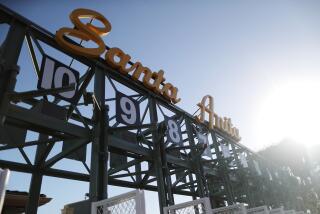BETTING THE SYSTEMS : Progressive Wagers on Favorites Won for Hawk
- Share via
When the Hawk went to his grave, he thought he had a system for beating the ponies. While he was alive, his only goal in life was to figure out how to leave the track with more money than he had when he arrived.
He really kind of looked like a hawk. He was tall and lean, had a lot of dark hair that constantly fell over his forehead and always wore an old black leather Air Force jacket. When he collected his winnings, he appeared to be just like a hawk swooping down on a lake in a straight dive to stab at the unsuspecting fish that had come too close to the surface.
The Hawk was different from most people. Most of the time, he never worked. He was drafted into the Army in World War II and won a fortune playing cards. With the money he won, he bought some horses. Since the horses never lived up to their expectations, the Hawk ended up a bettor rather than an owner. Sometimes he would get a job as a trainer, and as soon as he would save up a stake, he would quit and start betting over again.
The Hawk must have experimented with almost every system devised. He bet jockeys, trainers, heavyweights, lightweights, front-runners, horses that came from behind and others that made no sense whatsoever. He bet the colors of the silks, names of horses and probably even tried to talk to the horses in order to come up with a winner.
“Discovering a winning system takes time. Maybe even a lifetime,” he would tell his friends, staring at them with cold brown eyes that were surrounded by black circles.
It was late in life that the Hawk discovered there was a “favorite” in every race. Until then, the Hawk thought favorites were for amateurs. “Show me a chalk player, and I’ll show you a loser,” he would announce. Suddenly, he found, betting on favorites wasn’t such a bad idea after all. In fact, since favorites won from 30% to 33% of all the races, he thought that a progressive betting system on the favorites would make him a winner.
Although it might have seemed like sheer lunacy, the Hawk came up with the idea that a double-up system hooked up to the favorites would give him a profit for the day. Of course, the experts laughed, smiled at one another and concluded that the Hawk was losing his mind, that if he continued such betting there was nothing left for him but Social Security and a rocking chair in an old-age home.
The Hawk persisted, however, collected his money and may have had the last laugh on all those so-called experts.
If Hollywood Park’s summer season in 1989 was any example, the Hawk certainly came out a winner. Not only did 36% of the favorites win, but at least one favorite won every day of the meeting. Never was the favorite shut out. Seven of the racing days saw six favorites winning and seven other days resulted in five favorites winning.
One of the best days for the system was on June 7, 1989, when six consecutive favorites won. It started in the second race as S. S. T. Rose romped home a winner by a nose in six-furlong claimer for 3-year-old fillies and mares. Gold Impression won the third by 2 1/2 lengths and Kerry Pippin, a heavy betting choice, won the fourth easily by 2 3/4 lengths, going wire to wire over five furlongs in a race for 2-year-old maidens.
In the fifth, a 6 1/2-furlong sprint, Defend Your Man came from behind in a rush and finished 1 1/2 lengths in front. Agitated Mike won the sixth by five lengths, and Winchester Drive in the seventh went wire to wire to capture a six-furlong allowance race for 3-year-olds.
After losing the first race, the favorites romped home one after another, paying $8, $5.80, $2.80, $5, $6.60 and $8. Profit for the day came to $16.20. Another day, May 10, 1989, when the only favorite, paying $5, won the seventh race, you would have ended up with a $60 profit for the day.
Another winning day for the system was April 30, 1989, when the favorites won the first six races. They were Biscayne Boy, $8.60; Premium Award, $3.80; Mispu, $6.80; Paper Princess, $5.60; Ono Gummo, $4.80, and Commandperformance, $5.20. Since you would have lost the last three races, your profit for the nine races would have been only $8.80.
Obviously, the Hawk was willing to risk a lot of money for a relatively small amount of return. He worked on the idea that a big number of small wins would counteract the losses. He played a double-up system starting with a $2 bet on the first race. For nine straight losses, the Hawk would have had to shell out $1,022. Fortunately, there was never a day that a favorite didn’t win.
Actually, there are many types of progression systems. In every one, however, the general aim is the same: to bet enough so that the lowest possible return adds up to more than the total wagered. Also, after a win, the bettor must return to the original bet.
“I’m no piker,” the Hawk would tell you, scrutinizing the totalizator board and staring at the numbers. “Sometimes you just have to take a chance.” At least taking a fling with $1,022 is better than playing Russian roulette. “It’s only money,” you might philosophize about the betting. “Easy come, easy go.” But pointing a loaded gun at your head is another matter.
More to Read
Go beyond the scoreboard
Get the latest on L.A.'s teams in the daily Sports Report newsletter.
You may occasionally receive promotional content from the Los Angeles Times.









